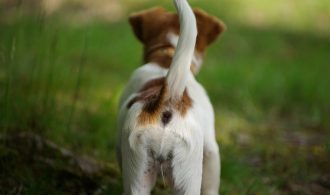Some content may contain affiliate links to products which means we could earn a fee on your purchase. Thank you for visiting
For the past 12 years, I know I’ve gotten off pretty easy when it comes to matters of my dog’s hind end. But last week, all that good luck came to a screeching halt when a vet tech noticed my male dog leaking brown fluid from his bum. And for the first time in his life and probably going forward, my senior, arthritic dog is on high-alert when it comes to his anal glands and I’ll share exactly what happened and why the sudden change in this article.
Male Dog Leaking Brown Fluid: Possible Suspects
When this brown fluid is coming from the anus it could be: Leaking anal glands, an infected or abscessed anal gland, blood (often looks brown).
And because you don’t know the reason, a call to your vet is ALWAYS step 1. But in my case, I had no idea this was happening until a very conscientious vet-tech noticed spotting on the underside of my dog’s tail during his rehab stretching exercises.
Upon further examination she stopped the therapy session and called for a Dr. to come have a look.
A few minutes later, the Dr. arrived and I was shocked to learn that for the first time ever and, unbeknownst to us, Frodo had a full anal gland that was leaking brown fluid and it had to be manually cleared.
My Experience With a Dog’s Anal Glands
I am not oblivious to the fact that dogs have anal glands. In fact, a very dear friend of mine (Eugene) is a lover of basset hounds and every single one of them has to get their glands expressed by the vet on a regular basis. So … I know anal glands exist, I know that can get impacted and I know their contents stink like a rotten sewage sandwich.
But until this moment, my dog never, ever had a problem clearing his anal glands via the normal method (defecating).
Vet Procedure for Clearing a blocked Anal Gland
My 90 pound dog was already laying down and so the vet tech and I hugged him really tight and kept him on the floor, on his side. Meanwhile, the Dr went inside his bum with gloved fingers and extruded the nasty mess. Frodo’s appreciation level: Negative 1000. He writhed and yelped while trying his best to get out of our grip.
It took about 3 or 4 clearings, each time with a new glove until the gland was empty. Then, to get a closer look, they shaved the surrounding area near his bum. That’s when they discovered a small, open slit about an inch to the right of his anus, which meant that his anal gland was headed for a rupture.
Anal Gland Rupture: That means there was so much fluid in the gland and it had nowhere to go. When this happens, it ruptures through the dog’s skin and usually becomes an abscessed nightmare which is quite painful for the dog to live with.
Lucky for us, the entire issue was caught in time and my dog was spared this painful condition. And I really cannot thank my vet-tech enough for paying such close attention to my dog’s body.
Anal Gland Home Treatment Plan: Our Job
Our vet wanted us to complete an antibiotic cycle and she also gave us a probiotic supplement to give once per day. We added some pumpkin to his raw diet (link: learn the raw diet and see my recipe). and we upped his CBD dose while we work through his knee injury. You can read about CBD for dogs with mobility issues here: (link to our CBD article).
I’m happy to report that we completed the antibiotic and probiotic course and my dog is doing so much better. There is no more leaking brown fluid and his energy and spunk is 100% back.
Anal Gland Issues: Easy to Miss
I have to imagine that it took a while for my dog’s anal gland to get this impacted. He’s got a good 3-4 inches of thick fur near his bum and I would never have seen the open wound without it being shaved.
While this issue was progressing, my dog was probably feeling worse and worse. And when you have a senior, arthritic dog with a knee injury, it’s easy to associate lack of energy with getting older and the effects of arthritis and a painful injury.
My vet believes that because my dog is working through a recent knee injury (that’s why we’re in therapy) he is not posturing correctly when he defecates and she sees this in arthritic dogs as well.
Bottom line? A dog can go their entire lives without anal gland issues and then begin to experience problems at the onset of mobility issues such as arthritis or injuries. If your dog falls into this category, and you’re seeing brown fluid, it’s well worth a vet visit and time to get educated on the anal glands.
What I learned from this Anal Gland Ordeal
Gratitude: My overwhelming emotion was that I had the best vet-tech in the world. She and the Dr. have become important pillars in my dog’s health and I couldn’t be more grateful to have found them.
Education: From a health perspective, I learned that arthritis and mobility issues can impact a how a dog postures while defecating and that can lead to horrible anal gland issues.
Empathy: Then it later occured to me: The Dr. that was called to come have a look at my dog and spent 15 minutes clearing his anal gland was (no doubt) pulled away from other clients with appointments.
Upon reflection, I can remember times when I’ve gotten somewhat agitated waiting for the vet to arrive in our room. I would think to myself: What’s the purpose of an appointment? or Why are Vet’s always late?
Well, newsflash to self: Emergencies happen and good vet’s take care of them! As such, here is how I’m going to handle delays at the vet going forward: I promise to never get agitated again if my vet is running behind schedule. I will think back to this day and remember how my dog’s emergency took the Dr. away from another dog owner’s appointment.
Not only will I not get agitated, but I will take a moment and send kind thoughts and pray that everything is okay with the animal in need. Then, I’ll smile and warmly greet the Dr. when she gets to us.
Thanks for visiting SeniorDogDays!

